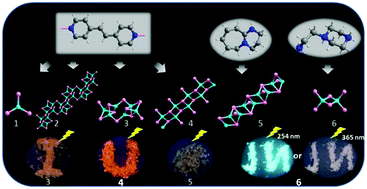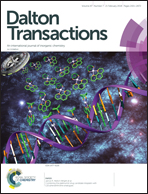The structures, water stabilities and photoluminescence properties of two types of iodocuprate(i)-based hybrids†
Abstract
Although great progress has been made in hybrid iodocuprates(I) as lighting phosphors, the effects of aromatic and aliphatic structure directing agents (SDAs) on their water stability, structure and photoluminescence (PL) properties are still not clear. Herein, aromatic N-heterocyclic 1,2-di(4-pyridyl)ethylene (dpe), aliphatic N-heterocyclic 1,8-diazabicyclo[5.4.0]undec-7-ene (dbu) and N-aminoethylpiperazine (app) were selected to be SDAs to construct two types of hybrid iodocuprates(I) via a facile in situ approach. Aromatic dpe-derived cations are successfully directed to form (Me2dpe)(CuI3) (1), (Me2dpe)n(Cu4I6)n (2), (Et2dpe)2(Cu6I10) (3), and (H2dpe)n(Cu2I4)n (4). Three of them contain unprecedented inorganic iodocuprate clusters or chains. The aliphatic N-heterocyclic dbu- and app-derivative cations are responsible for the formation of (Hdbu)n(Cu2I3)n (5) and (H3app)2(Cu2I6)·2I·2H2O (6), which contain a (Cu2I3)− chain and a (Cu2I6)4− binuclear cluster, respectively. For the first time, the influence mechanisms of the water stabilities of iodocuprate-based PL materials were disclosed, by analyzing the possible interactions between SDAs and water molecules. 1–2 are PL silent due to their “self-quenching effect”. 3, 4 and5 exhibit bright red, orange and yellow solid-state PL emissions at room temperature respectively, originating from the charge transfer between inorganic iodocuprate species and organic N-heterocycles. The co-template approach leads to multiple charge transfers in 6, which features a tunable PL behavior from bluish green to white by varying the excitation light, and has a quantum yield up to 43% (the highest value among hybrid iodocuprates containing (Cu2I6)4− clusters). The comparative study not only helps us to rationally synthesize iodocuprate-based PL materials with enhanced performance, but also provides a new method to obtain wavelength-dependent PL materials.



 Please wait while we load your content...
Please wait while we load your content...